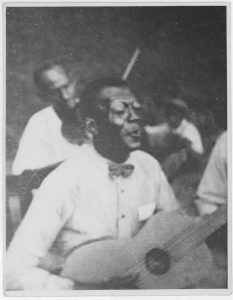In 1938, American ethnomusicologist Alan Lomax and the self-proclaimed inventor of jazz Jelly Roll Morton came together to lay down the definitive timeline for the birth of jazz. Their recording session resulted in a 9-hour collection of Jelly Roll Morton songs and interviews between Morton and Lomax. In the first song recorded during these sessions, Winin’ Boy Blues, Morton sings the lines
I’m the winin’ boy, don’t deny my name
I can pick it up and shake it like Stavin’ Chain’s
(Caution: this song contains some of the most explicit lyrics I’ve ever heard)
The phrase Stavin’ Chain stood out to me. What exactly is a Stavin’ Chain? Upon investigation, I found that this is not the only instance of a blues/jazz singer singing about Stavin’ Chain. There were songs by Lil Johnson (Stavin’ Chain) and “Big” Joe Williams (Stavin’ Chain Blues) that refer to Stavin’ Chain. From browsing various blues forum websites, I have found a variety of interpretations to what a Stavin’ Chain is. Some say it is a tool used to make barrels. Others claimed that Stavin’ Chain is a figure in African-American folklore famous for conducting trains. One man claimed that it’s an expression for having sex. Luckily, I was able to find an interview between Lomax and Morton about this very subject in Jelly Roll Morton: The Complete Library of Congress Recordings.
Taken from the recording Bad Men and Pimps
Lomax: And what about Stavin’ Chain?
Jelly Roll: Stavin’ Chain, well he was a pimp. Supposed to have more women in this district than any other pimp.
Lomax: Did you actually know Stavin’ Chain?
Jelly Roll: No, I heard everybody talk about him, never get into his way…
Lomax: What what did you hear about him, this is very interesting cause, you know, they have a song about Stavin’ Chain
Jelly Roll: Well, you know, he slept like Stavin’ Chain.
Lomax: Good tune, too.
Jelly Roll: Yes, I like the tune, I can’t, couldn’t memorize the tune, you know…
Lomax: Popular around New Orleans as well.
Jelly Roll: Yeah, at one time it was. Let’s see… that was around….19….8.
Lomax: Was Stavin’ Man a white man or colored one?
Jelly Roll: A colored one.
Lomax: Supposedly good looking.
Jelly Roll: Yes, he………. Women was supposed to be crazy about him.
As it turns out, Lomax knew this Stavin’ Chain character that Morton was singing about. Stavin’ Chain, also known as Wilson Jones, was an American blues musician that Lomax photographed and recorded in 1934. Stavin’ Chain was famous for his sexual prowess became a legend in the American blues scene. I’ve found that American blues music is one with an extremely rich history and is full of similar, obscure references. Hours of research can be done unpacking and contextualizing the lyrics from this music. For being able to do this, we owe much gratitude to Alan Lomax for preserving this music for future study and enjoyment.
https://www.youtube.com/watch?v=GX_QKr_mssM
Sources
“Bad Men and Pimps.” YouTube. February 11, 2015. Accessed October 02, 2017. https://www.youtube.com/watch?v=iwxP8uT-zQ4.
“Jelly Roll Morton – Winin’ Boy Blues – Library of Congress 1939.” YouTube. June 02 2015. Accessed October 02, 2017. https://www.youtube.com/watch?v=fxkvu_gWlQI
Lomax, Alan 1915-2002. “Lomax Collection.” [Stavin’ Chain playing guitar and singing the ballad “Batson,” Lafayette, La. (fiddler in the background)]. January 01, 1970. Accessed October 02, 2017. http://www.loc.gov/pictures/collection/lomax/item/2007660070/.
“Winin’ Boy Blues.” Community Guitar Home. Accessed October 3, 2017. http://www.communityguitar.com/students/Songs/WininBoy.htm.


